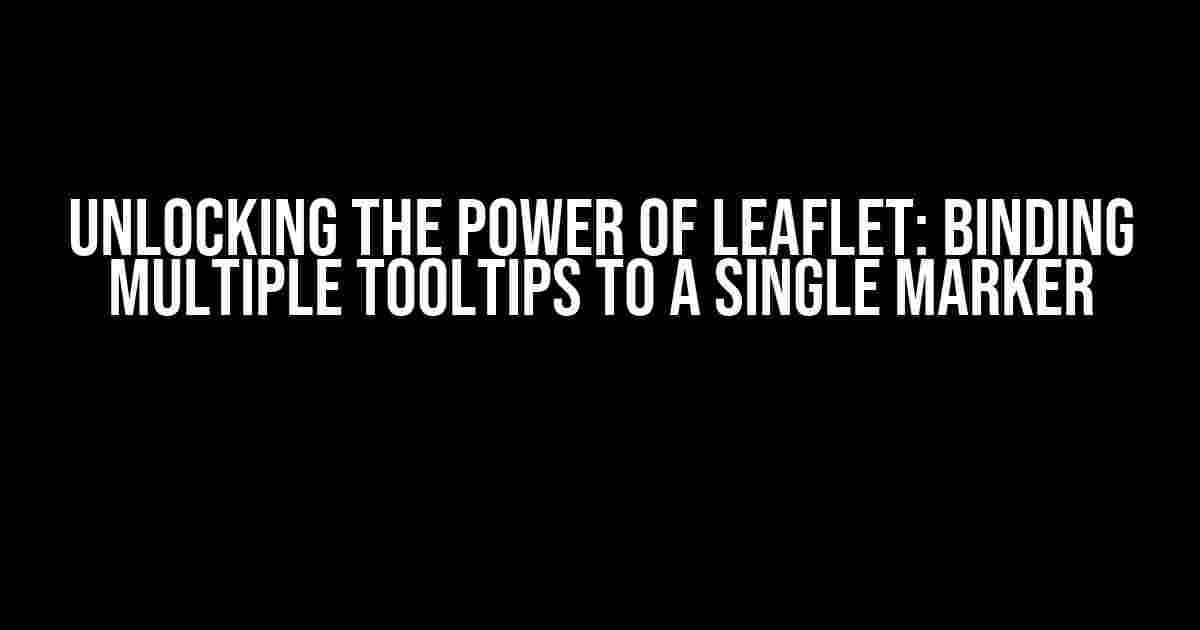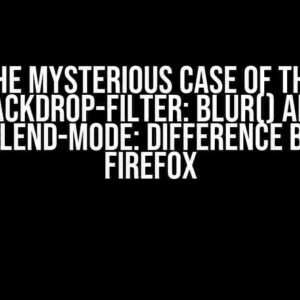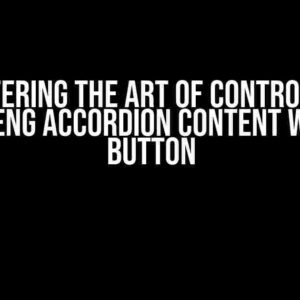Are you tired of being limited to just one tooltip per marker in Leaflet? Do you want toUnlock the full potential of your mapping experience and provide your users with a wealth of information at their fingertips? Look no further! In this comprehensive guide, we’ll dive into the world of binding multiple tooltips to a single Leaflet marker, and show you how to take your mapping skills to the next level.
Why Multiple Tooltips Matter
Let’s face it – a single tooltip can only convey so much information before it becomes overwhelming or cluttered. By binding multiple tooltips to a single marker, you can:
- Provide a more detailed and nuanced understanding of a location
- Highlight different aspects of a feature or point of interest
- Enhance the user experience with a more dynamic and interactive mapping environment
- Support multiple languages or data sources with ease
Getting Started: The Basics of Leaflet Markers and Tooltips
Before we dive into the nitty-gritty of binding multiple tooltips, let’s quickly review the basics of Leaflet markers and tooltips. If you’re already familiar with these concepts, feel free to skip ahead!
Leaflet Markers
A Leaflet marker is a visual representation of a point of interest on a map. You can create a basic Leaflet marker using the following code:
<script> var marker = L.marker([51.505, -0.09]).addTo(map); </script>
Leaflet Tooltips
A Leaflet tooltip is a small, interactive box that appears when a user hovers over a marker. You can create a basic Leaflet tooltip using the following code:
<script>
var marker = L.marker([51.505, -0.09]).bindTooltip("Hello, World!").addTo(map);
</script>
Now that we’ve covered the basics, let’s explore the different approaches to binding multiple tooltips to a single Leaflet marker.
Method 1: Using the `bindTooltip` Method with an Array
One approach is to pass an array of tooltips to the `bindTooltip` method. Here’s an example:
<script>
var tooltips = [
"Tooltip 1: This is a basic tooltip.",
"Tooltip 2: This is another tooltip with some additional information.",
"Tooltip 3: And this is a third tooltip with even more details."
];
var marker = L.marker([51.505, -0.09]).bindTooltip(tooltips, {
direction: "top",
permanent: true
}).addTo(map);
</script>
This method is straightforward, but it has some limitations. For example, you can only use this approach if all of your tooltips have the same direction and permanent settings.
Method 2: Using Multiple `bindTooltip` Calls
An alternative approach is to use multiple `bindTooltip` calls to add each tooltip individually. Here’s an example:
<script>
var marker = L.marker([51.505, -0.09]).addTo(map);
marker.bindTooltip("Tooltip 1: This is a basic tooltip.", {
direction: "top",
permanent: true
});
marker.bindTooltip("Tooltip 2: This is another tooltip with some additional information.", {
direction: "right",
permanent: false
});
marker.bindTooltip("Tooltip 3: And this is a third tooltip with even more details.", {
direction: "bottom",
permanent: true
});
</script>
This method offers more flexibility, as you can customize the direction and permanent settings for each tooltip individually. However, it can become cumbersome if you need to add a large number of tooltips.
Method 3: Using a Custom Tooltip Function
A more advanced approach is to create a custom tooltip function that returns an array of tooltips. Here’s an example:
<script>
function getTooltips() {
return [
{
content: "Tooltip 1: This is a basic tooltip.",
direction: "top",
permanent: true
},
{
content: "Tooltip 2: This is another tooltip with some additional information.",
direction: "right",
permanent: false
},
{
content: "Tooltip 3: And this is a third tooltip with even more details.",
direction: "bottom",
permanent: true
}
];
}
var marker = L.marker([51.505, -0.09]).bindTooltip(getTooltips()).addTo(map);
</script>
This method offers the most flexibility, as you can customize the tooltips using JavaScript logic and return an array of tooltips dynamically.
The Power of Customization
One of the key benefits of binding multiple tooltips to a single Leaflet marker is the ability to customize each tooltip to your heart’s content. Here are some ideas to get you started:
- Dynamic Content: Use JavaScript to dynamically generate tooltip content based on user input, data sources, or other factors.
- Images and Icons: Add images, icons, or other multimedia elements to your tooltips to enhance the user experience.
- Conditional Logic: Use conditional logic to display different tooltips based on user behavior, location, or other factors.
- Accessibility Features: Implement accessibility features such as keyboard navigation, screen reader support, or high contrast mode.
Conclusion
Binding multiple tooltips to a single Leaflet marker is a powerful technique that can elevate your mapping experience and provide your users with a wealth of information at their fingertips. Whether you’re using the `bindTooltip` method with an array, multiple `bindTooltip` calls, or a custom tooltip function, the possibilities are endless. So why settle for a single tooltip when you can have multiple?
| Method | Advantages | Disadvantages |
|---|---|---|
| Using the `bindTooltip` Method with an Array | Easy to implement, supports multiple tooltips | Limited customization options, requires same direction and permanent settings |
| Using Multiple `bindTooltip` Calls | More flexible than the array method, supports different direction and permanent settings | Can become cumbersome with a large number of tooltips |
| Using a Custom Tooltip Function | Offers the most flexibility, supports dynamic content and customization | Requires more advanced JavaScript skills, can be more complex to implement |
Remember, the key to unlocking the full potential of Leaflet is to experiment, innovate, and push the boundaries of what’s possible. So, go ahead – get creative with your tooltips and take your mapping experience to the next level!
References
For more information on Leaflet and its various features, we recommend checking out the official Leaflet documentation and API reference:
Happy mapping!
Frequently Asked Questions
Having trouble binding multiple tooltips to a single Leaflet marker? Don’t worry, we’ve got you covered! Here are some frequently asked questions to help you troubleshoot the issue.
How can I bind multiple tooltips to a single Leaflet marker?
You can bind multiple tooltips to a single Leaflet marker by creating separate tooltip elements for each tooltip and then adding them to the marker using the `bindTooltip()` method. For example, you can create two tooltips and bind them to the same marker like this: `marker.bindTooltip(tooltip1).bindTooltip(tooltip2)`. This way, both tooltips will be displayed when the marker is hovered over.
Can I use a single tooltip element to display multiple messages?
Yes, you can use a single tooltip element to display multiple messages by concatenating the messages into a single string. For example, you can create a tooltip element with the text `tooltip1 + ‘
‘ + tooltip2` and then bind it to the marker using the `bindTooltip()` method. This way, both messages will be displayed in the same tooltip, separated by a line break.
How can I customize the appearance of multiple tooltips bound to a single marker?
You can customize the appearance of multiple tooltips bound to a single marker by using CSS to style the tooltip elements. For example, you can add different background colors, font sizes, or padding to each tooltip element to distinguish them from each other. You can also use JavaScript to dynamically update the styles of the tooltips based on certain conditions.
Can I bind multiple tooltips to a single Leaflet marker using a loop?
Yes, you can bind multiple tooltips to a single Leaflet marker using a loop. For example, you can create an array of tooltips and then use a loop to bind each tooltip to the marker using the `bindTooltip()` method. This way, you can easily add or remove tooltips from the marker without having to manually update the code.
What are some common use cases for binding multiple tooltips to a single Leaflet marker?
Binding multiple tooltips to a single Leaflet marker is useful in scenarios where you need to display multiple pieces of information about a location, such as a business address, phone number, and website. It can also be used to display different types of data, such as weather information, traffic updates, or nearby attractions. Additionally, you can use multiple tooltips to provide a more detailed description of a location, such as a brief history, architectural style, or cultural significance.







